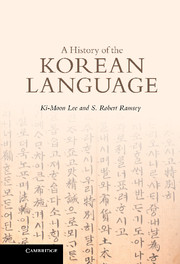Book contents
6 - Early Modern Korean
Published online by Cambridge University Press: 05 June 2012
Summary
What is referred to here as “Early Modern Korean” extended from the beginning of the seventeenth century down to the end of the nineteenth century. It is the stage of the language represented in the texts written after the end of the Middle Korean period but before writing practices were updated and rationalized to reflect contemporary speech around the turn of the twentieth century. Early Modern Korean was, in that sense, a transition stage between Middle Korean and Contemporary Korean.
The Early Modern period began after the Japanese invasion of Korea in 1592. That invasion, followed by the seven, horrific years of the Imjin Wars, followed in turn by more years of widespread famine and disease, exacted a terrible price on Korean society. No books were published during that time, and when publication did resume around fifteen years later, Korean writing had changed. Gone were the diacritic dots used to mark tones; the triangle symbol used to write z had disappeared; consonant clusters and other kinds of spellings were confused and inconsistent; grammatical patterns and styles were noticeably altered. The differences in the textual records were so great, in fact, it was long believed that the wars with the Japanese had caused people to change the way they talked. Even today one sometimes hears it said that Hideyoshi's invasions caused Koreans to forget how to pronounce z's or to distinguish tones.
- Type
- Chapter
- Information
- A History of the Korean Language , pp. 241 - 286Publisher: Cambridge University PressPrint publication year: 2011

